back to bread
September 18, 2012 § 16 Comments
We had so many hot dry days (a record number) this summer, but the autumnal equinox is right around the corner. Cooler night time temperatures are reminding the tomatoes they need to hurry up and ripen, and the day time temps are bouncing from the 80’s to 60’s. I took advantage of a 60 degree day to bake the Whole Wheat loaves from Baking with Julia with the TWD group today.
Farmer John (yes, that is really his name) has been experimenting with growing grains in Boulder County the last few years, with rye joining his hard red winter wheat this year. I like the flavor of rye so I added a little to this recipe. And while Craig Kominiak’s recipe called for malt extract (available at beer brewing supply stores) I used the barley malt syrup I had on hand. It contributed a rounded toasted sweetness to the bread, along with the small amount of honey called for. I skipped adding the even smaller amount of oil in the recipe.
For baking I almost always use a scale to measure ingredients by weight, and I find it especially important when baking bread to help get predictable and consistent results. I use 5 oz. per cup of flour (any type, it’s close enough), 7 oz. per cup of granulated or brown sugar, 8 oz. works for a cup of most liquids, water, milk, oils, butter, but not all (honey is much denser than water for instance). I found this recipe on the dry side for me and at our altitude of 5000′. For the total two pounds of flour, I up’d the water to 2 3/4 cups. In baker’s math, this means 22 oz. water/32 oz. flour = 68%, which is the target hydration that tends to give results I like. I also had to lengthen the baking time by about 10 minutes for this wetter dough.
I lightly mixed all the ingredients together except for the salt, covered the dough and let it rest for a half hour. I like to do this for a couple of reasons. Salt strengthens gluten and inhibits yeast activity, so I lighten the load on my mixer a bit and let the yeast get going. The rest period allows the flour grains to thoroughly hydrate and gluten actually starts to develop on its own. You can even see a few strands in the second picture after the dough has rested and even risen a bit.
I sprinkle the salt over the rested dough and then mix with the dough hook on a low speed (2 on the KitchenAid). It only takes 4-5 minutes instead of the 10 minutes at medium to achieve a well-kneaded dough with adequate gluten development.
I had an appointment in town and some errands to run so I covered the dough and popped it into the refrigerator for a slow leisurely rise (this is called retarding since you’re slowing the dough’s activity).
The dough was fully risen without being over-fermented by the time I got back home 3-4 hours later. I decided to roll in some plumped raisins, chopped toasted walnuts and some chopped candied orange peel leftover from poaching apples for FFwD last week.
The recipe makes two loaves, so I made one plain and the other with the raisin nut add-ins. Don’t forget to butter the baking dish!
Since the dough is chilled from the refrigerator it takes over an hour to rise enough to fill the pans. And being half whole grain and half white flour, the loaves are pretty heavy and don’t rise much more in the oven.
This bread had a very moist crumb that benefits from toasting. Some butter and cinnamon sugar doesn’t hurt either!

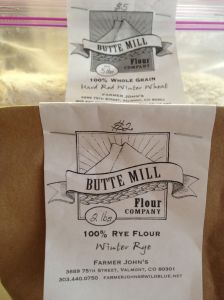
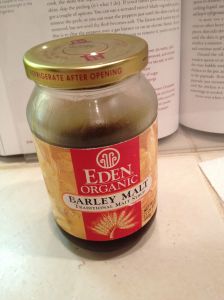



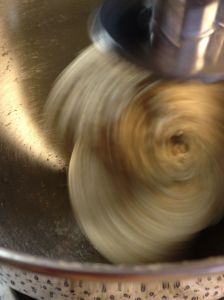




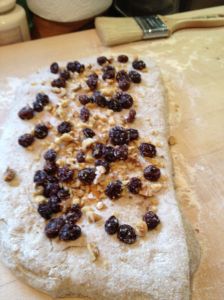

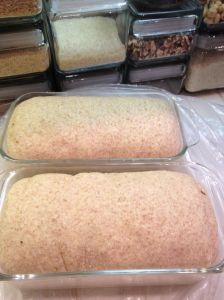
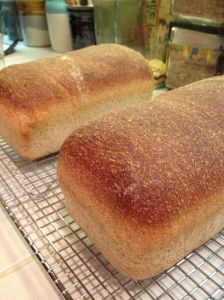
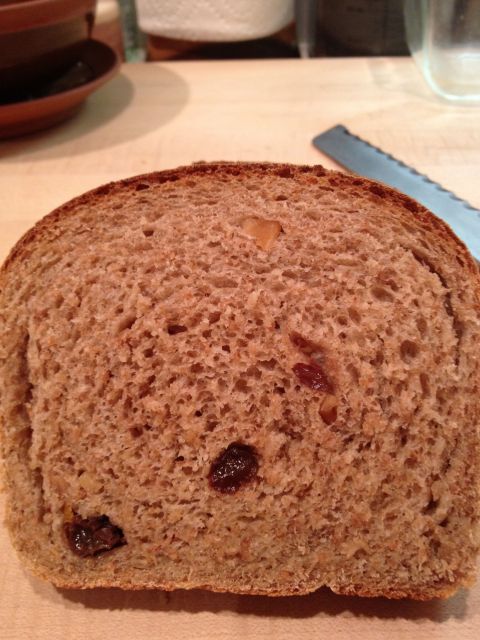
Gorgeous loaves Marilyn! I usually add seeds but a sweeter version with candied orange (which I love) sounds really yummy. This is such a staple bread for me. Have a great day!
Yum! I love your add-ins. I used the barley syrup as well and it was delish.
Marilyn, great information here…even some baker’s math…yowza! Beautiful loaves indeed!
Carmen
I love getting the benefit of all your experience in your posts. Your bread is lovely and I really like the way you used the leftovers from the poached apples, too.
very handsome loaves! i often do the technique of resting the dough before adding salt when i make pizza dough, should have tried it here, too.
Beautiful loaves! I especially love the look of the rasins in the bread.
I feel like I always learn something reading your posts 🙂 Your loaves look delicious!!
Beautifully done.
I hadn’t thought about the target hydration in those terms before (it usually only crosses my mind when I am doing sourdough). That’s what I love about TWD – learning from other’s experience 🙂
Bread with raisins and candied orange peel – what a tasty variation. Great post.
Yum, yum, yum! Love your variations. Blessings, Catherine http://www.praycookblog.com
Marilyn, I will definitely follow your “measurement by weight” guidelines next time – we only use metric measurements around here and I always have to struggle with conversions because I never ever find them to be accurate enough! Thanks for the instructive post, I greatly enjoyed reading it and learning from you and I love the way your loaves look like – by the way, letting the yeast dough slowly “rise” in the refrigerator really does make for improved baked goods, I agree.
So salt is an inhibitor – thanks for explaining that. When making bread dough, do you always add the salt after the first rise? I also found that the dough needed more water than what the recipe called for. Bread with candied orange peels – awesome idea!
Although a lot of recipes call for adding the salt later, I don’t find that it makes a lot of difference for yeasted breads and I often just add it with the rest of the ingredients at the beginning. I do add it later for sourdough or levain doughs though, since those ferment at a much slower rate. I also found this dough very dry so added more water as well. If the dough isn’t wet enough to dissolve the salt, it’s helpful to mix the salt in a little water before adding to an already formed dough.
Beautifully done! Love the loaf with the raisins and nuts…a very good idea!
Yum! I thought about adding cinnamon and raisins during the rolling process and I think I will next time thanks to you! Your breads look delicious and I really like the tip about letting the dough rise so as to be easier on your mixer. I’d like to make this bread at home but I’m a little afraid for my Artisan Mixer – maybe trying your modification would help.
What a lovely step by step post. Your bread looks beautiful and with all your add-ins, it must be delicious.
This is my favourite recipe from the book, so far.